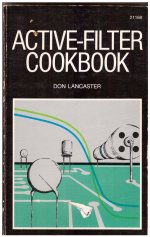It took a few years of prodding, but TI has put the Nat Semi Audio Handbook online -- divided into parts:
Blast from the Past! 1980 NSC Audio/Radio Handbook! - Audio Amplifiers Wiki - Audio Amplifiers - TI E2E Community
Blast from the Past! 1980 NSC Audio/Radio Handbook! - Audio Amplifiers Wiki - Audio Amplifiers - TI E2E Community
Cool, my paper copy got lost in the shuffle somewhere.
Now does anyone remember the old joke data sheets like the DED (dark emitting diode, National Semi I think) and the WOM (write only memory, Signetics). And does anybody have a scan of those?
There have been a couple of threads about what happens to an LED when it is operated way beyond its ratings. The obvious answer is that it becomes a DED. Google only turns up some vague memories and a story or two, but nobody seems to have the actual data sheets.
I believe that NSM also had a spec for a "totally transparent audio chip." It had a direct internal connection from the input pin to the output pin, and specs showing a flat frequency response from DC to several MHz. Very low power consumption too.
I vaguely remembering some funny graphs like number of socket insertions VS number of pins remaining........
Now does anyone remember the old joke data sheets like the DED (dark emitting diode, National Semi I think) and the WOM (write only memory, Signetics). And does anybody have a scan of those?
There have been a couple of threads about what happens to an LED when it is operated way beyond its ratings. The obvious answer is that it becomes a DED. Google only turns up some vague memories and a story or two, but nobody seems to have the actual data sheets.
I believe that NSM also had a spec for a "totally transparent audio chip." It had a direct internal connection from the input pin to the output pin, and specs showing a flat frequency response from DC to several MHz. Very low power consumption too.
I vaguely remembering some funny graphs like number of socket insertions VS number of pins remaining........
Flooby Dust
Pease had a wonderful sense of humor -- tragedy that he lost his life driving back from Jim Williams funeral.
Pease had a wonderful sense of humor -- tragedy that he lost his life driving back from Jim Williams funeral.
Thanks for posting.
I also have my copy "somewhere".
A real gem.
This one, plus Op Amp Cookbook and Active Filter Cookbook were enough to launch a successful career 😉
I also have my copy "somewhere".
A real gem.
This one, plus Op Amp Cookbook and Active Filter Cookbook were enough to launch a successful career 😉
This one, plus Op Amp Cookbook and Active Filter Cookbook were enough to launch a successful career 😉
You mean these? Maybe I can get WJ to sign ...
Attachments
Are they going to put up the 1976 version?
I downloaded a very good scan of it a while back, but can't seem to find it online now ....
Win W5JAG
I downloaded a very good scan of it a while back, but can't seem to find it online now ....
Win W5JAG
Floobydust
“Floobydust”
In the 1976 National Semiconductor - Audio Handbook the word “Floobydust” is defined as:
“Floobydust” is a contemporary term derived from the archaic Latin miscellaneus,
whose disputed history probably springs from Greek origins (influenced, of course, by Egyptian linguists) - meaning here “a mixed bag.”
Later in 1991 Bob Pease (Staff Scientist at National Semiconductor) defined the word in his Book
“Troubleshooting Analog Circuits” as:
“Floobydust” is an old expression around our lab that means potpourri, catch-all, or miscellaneous.
In this chapter, I’ll throw into the “Floobydust” category a collection of philosophical items,
such as advice about planning your troubleshooting, and practical hints about computers
and instruments.
Bob Pease (RIP) sometimes used the word in his columns in Electronic Design Magazine.
“Floobydust”
In the 1976 National Semiconductor - Audio Handbook the word “Floobydust” is defined as:
“Floobydust” is a contemporary term derived from the archaic Latin miscellaneus,
whose disputed history probably springs from Greek origins (influenced, of course, by Egyptian linguists) - meaning here “a mixed bag.”
Later in 1991 Bob Pease (Staff Scientist at National Semiconductor) defined the word in his Book
“Troubleshooting Analog Circuits” as:
“Floobydust” is an old expression around our lab that means potpourri, catch-all, or miscellaneous.
In this chapter, I’ll throw into the “Floobydust” category a collection of philosophical items,
such as advice about planning your troubleshooting, and practical hints about computers
and instruments.
Bob Pease (RIP) sometimes used the word in his columns in Electronic Design Magazine.
Nah, Floobydust is what's left after the fire gods have danced all over your circuit turning all the silicon parts and their plastic packages into Floobydust.
“Floobydust”
whose disputed history probably springs from Greek origins (influenced, of course, by Egyptian linguists) - meaning here “a mixed bag.”
bursa mixta
I know this thread is a bit dated but I found a copy of the 1976 National Semiconductor Audio Handbook
http://bitsavers.trailing-edge.com/components/national/_dataBooks/1976_National_Audio_Handbook.pdf
Not sure how long these things stay out there.
Great book. I still have my paper copy.
http://bitsavers.trailing-edge.com/components/national/_dataBooks/1976_National_Audio_Handbook.pdf
Not sure how long these things stay out there.
Great book. I still have my paper copy.
- Status
- Not open for further replies.
- Home
- Member Areas
- The Lounge
- National Semiconductor Audio Handbook now Online

